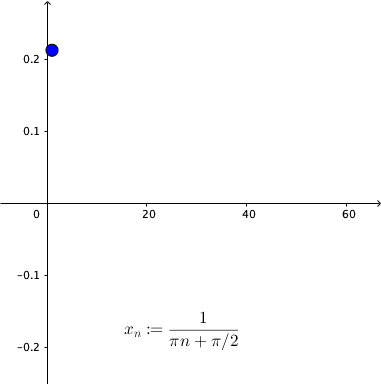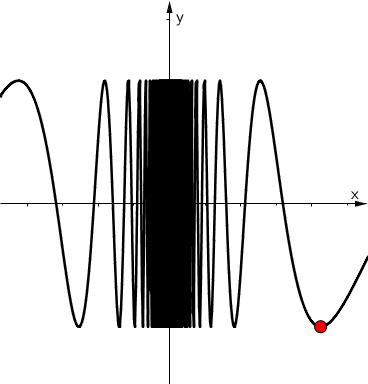Mathematical Analysis
Leture 9
5.1 Definition and basic properties
Definition 5.1.1.
Let $S \subseteq \R$, $c \in S$, and let $f \colon S \to \R$ be a function.
We say
that $f$ is continuous at $c$
if for every $\epsilon \gt 0$
there is a $\delta \gt 0$ such that whenever $x \in S$ and $\abs{x-c} \lt
\delta$, then
$\abs{\,f(x)-f(c)} \lt \epsilon$.
When $f \colon S \to \R$ is continuous at all $c \in S$, then we simply say
$f$ is a continuous function.
5.1 Definition and basic properties
$f$ is continuous at $c$
if for every $\epsilon \gt 0$
there is a $\delta \gt 0$ such that
whenever $x \in S$ and $\abs{x-c} \lt
\delta$, then
$\abs{\,f(x)-f(c)} \lt \epsilon$.
5.1 Definition and basic properties
Example
5.1 Definition and basic properties
Theorem 5.1.1. Consider a function $f \colon S \to \R$ defined on a set $S \subseteq \R$ and let $c \in S$. Then
- If $c$ is not a cluster point of $S$, then $f$ is continuous at $c$.
- If $c$ is a cluster point of $S$, then $f$ is continuous at $c$ if and only if the limit of $f(x)$ as $x \to c$ exists and \begin{equation*} \lim_{x\to c} f(x) = f(c) . \end{equation*}
- The function $f$ is continuous at $c$ if and only if for every sequence $\{ x_n \}$ where $x_n \in S$ and $\lim\, x_n = c$, the sequence $\{ \,f(x_n) \}$ converges to $f(c)$.
Proof of Theorem 5.1.1
Proof.
Let's prove item 1: If $c$ is not a cluster point of $S$, then $f$ is continuous at $c$.
Suppose $c$ is not a cluster point of
$S$.
Then there exists a $\delta > 0$
such that
$S \cap (c-\delta,c+\delta)$ $= \{ c \}.$
For any $\epsilon > 0$, simply pick this given $\delta$. The only $x \in S$ such that $\abs{x-c} \lt \delta$ is $x=c$.
$\Ra \;\abs{\,f(x)-f(c)} $ $ = \abs{\,f(c)-f(c)} $ $= 0 $ $\lt \epsilon.$
Proof of Theorem 5.1.1
Proof. Now let's prove item 2: If $c$ is a cluster point of $S$, then $f$ is continuous at $c$ $\iff$ the limit of $f(x)$ as $x \to c$ exists and \begin{equation*} \lim_{x\to c} f(x) = f(c) . \end{equation*}
Suppose $c$ is a cluster point of $S$. $\nec$ First suppose $f$ is continuous at $c$. For every $\epsilon > 0$, there exists a $\delta \gt 0$ such that for $x \in S$ where $\abs{x-c} \lt \delta\;$ $\Ra \;\abs{\,f(x)-f(c)} \lt \epsilon$. This is true since $x \in S \setminus \{ c \} \subset S$. Therefore, $\lim_{x\to c} f(x) = f(c)$.
Proof of Theorem 5.1.1
Proof. Now let's prove item 2: If $c$ is a cluster point of $S$, then $f$ is continuous at $c$ $\iff$ the limit of $f(x)$ as $x \to c$ exists and \begin{equation*} \lim_{x\to c} f(x) = f(c) . \end{equation*}
Again we assume $c$ is a cluster point of $S.$ $\suf$ Now assume that the limit of $f(x)$ as $x \to c$ exists and $\lim_{x\to c} f(x) = f(c).$ Then for every $\epsilon > 0,$ there is a $\delta \gt 0$ such that if $x \in S \setminus \{ c \}$ and $\abs{x-c} \lt \delta\,$ $\,\Ra \abs{\,f(x)-f(c)} \lt \epsilon$. In particular $\abs{\,f(c)-f(c)} = 0 \lt \epsilon,$ and the definition of continuity at $c$ is satisfied.
Proof of Theorem 5.1.1
Proof. Finally item 3: The function $f$ is continuous at $c$ $\iff$ for every sequence $\{ x_n \}$ where $x_n \in S$ and $\lim\, x_n = c$, the sequence $\{ \,f(x_n) \}$ converges to $f(c)$.
$\nec$ Suppose $f$ is continuous at $c.$ Let $\{ x_n \}_{n=1}^\infty$ be a sequence such that $x_n \in S$ and $ x_n \to c$ as $n\to \infty.$ Let $\epsilon > 0$ arbitrary. This is true since $x \in S \setminus \{ c \} \subset S.$
Find a $\delta > 0$ such that $\abs{\,f(x)-f(c)} \lt \epsilon$ for all $x \in S$ where $\abs{\,x-c} \lt \delta.$ Find an $M \in \N$ such that for $n \geq M,$ we have $\abs{x_n-c} \lt \delta.$
Proof of Theorem 5.1.1
Proof. Finally item 3: The function $f$ is continuous at $c$ $\iff$ for every sequence $\{ x_n \}$ where $x_n \in S$ and $\lim\, x_n = c$, the sequence $\{ \,f(x_n) \}$ converges to $f(c)$.
$\nec$ Suppose $f$ is continuous at $c.$ Let $\{ x_n \}_{n=1}^\infty$ be a sequence such that $x_n \in S$ and $ x_n \to c$ as $n\to \infty.$ Let $\epsilon > 0$ arbitrary. This is true since $x \in S \setminus \{ c \} \subset S.$
Find a $\delta > 0$ such that $\abs{\,f(x)-f(c)} \lt \epsilon$ for all $x \in S$ where $\abs{\,x-c} \lt \delta.$ Find an $M \in \N$ such that for $n \geq M,$ we have $\abs{x_n-c} \lt \delta.$
Then for $n \geq M,$ we have that $\abs{\,f(x_n)-f(c)} \lt \epsilon,$ so $f(x_n) \to f(c)$ as $n\to \infty.$
Proof of Theorem 5.1.1
Proof. Finally item 3: The function $f$ is continuous at $c$ $\iff$ for every sequence $\{ x_n \}$ where $x_n \in S$ and $\lim\, x_n = c$, the sequence $\{ \,f(x_n) \}$ converges to $f(c)$.
$\suf$ We are going to prove the contrapositive. Suppose $f$ is not continuous at $c.$ Then there exists an $\epsilon > 0$ such that for every $\delta > 0,$ there exists an $x \in S$ such that $\abs{x-c} \lt \delta$ and $\abs{\,f(x)-f(c)} \geq \epsilon.$
Define a sequence $\{ x_n \}_{n=1}^\infty$ as follows. Let $x_n \in S$ be such that $\abs{x_n-c} \lt \dfrac{1}{n}$ and $\abs{\,f(x_n)-f(c)} \geq \epsilon.$
Proof of Theorem 5.1.1
Proof. Finally item 3: The function $f$ is continuous at $c$ $\iff$ for every sequence $\{ x_n \}$ where $x_n \in S$ and $\lim\, x_n = c$, the sequence $\{ \,f(x_n) \}$ converges to $f(c)$.
$\suf$ We are going to prove the contrapositive. Suppose $f$ is not continuous at $c,$ Then there exists an $\epsilon > 0$ such that for every $\delta > 0,$ there exists an $x \in S$ such that $\abs{x-c} \lt \delta$ and $\abs{\,f(x)-f(c)} \geq \epsilon$.
Define a sequence $\{ x_n \}_{n=1}^\infty$ as follows. Let $x_n \in S$ be such that $\abs{x_n-c} \lt \dfrac{1}{n}$ and $\abs{\,f(x_n)-f(c)} \geq \epsilon.$
Now $\{ x_n \}_{n=1}^\infty$ is a sequence in $S$ such that $x_n \to c$ as $n\to \infty,$ and such that $\abs{\,f(x_n)-f(c)} \geq \epsilon$ for all $n \in \N.$ Thus $\bigl\{ f(x_n) \bigr\}_{n=1}^\infty$ does not converge to $f(c).$ $\;\bs$
5.1 Definition and basic properties
Discontinuity criterion
Theorem 5.1.2. Let $S\subseteq \R$, let $f \colon S \to \R$ and let $c\in S$.
Then $f$ is discontinuous at $c$
if and only if
there exists a sequence $\{x_n\}$ in $S$ such that $\lim x_n = c,$ but the sequence $\left\{\,f(x_n)\right\}$ does not converge to $f(c)$.
5.1 Definition and basic properties
Example 5.1.1. $\displaystyle f(x)=\sin\frac{1}{x},$ for $x\neq 0$ and $f(x)=0$ for $x=0.$

|

|
| $x_n\ra 0$ as $n\ra \infty$. | $\qquad\qquad f\left(x_n\right)$ does not converge to $0$. |
5.1 Definition and basic properties
Theorem 5.1.3. Let $f \colon S \to \R$ and $g \colon S \to \R$ be functions continuous at $c \in S$.
- The function $h \colon S \to \R$ defined by $h(x) := f(x)+g(x)$ is continuous at $c.$
- The function $h \colon S \to \R$ defined by $h(x) := f(x)-g(x)$ is continuous at $c.$
- The function $h \colon S \to \R$ defined by $h(x) := f(x)g(x)$ is continuous at $c.$
- If $g(x)\not=0$ for all $x \in S$, the function $h \colon S \to \R$ defined by $h(x) := \dfrac{f(x)}{g(x)}$ is continuous at $c.$
Example 5.1.2.
Claim: The functions $\sin(x)$ and $\cos(x)$ are continuous.
Proof. Recall that $\abs{\sin(x)} \leq \abs{x},$ $\abs{\cos(x)} \leq 1,$ and $\abs{\sin(x)} \leq 1.$
$\Ra \ds \abs{\sin(x)-\sin(c)}$
$\ds =\abs{
2 \sin \left( \frac{x-c}{2} \right) \cos \left( \frac{x+c}{2} \right)
}$
$\ds =
2
\abs{ \sin \left( \frac{x-c}{2} \right) }
\abs{ \cos \left( \frac{x+c}{2} \right) }
\qquad\quad$
$\ds \leq
2
\abs{ \sin \left( \frac{x-c}{2} \right) }$
$\ds \leq
2
\abs{ \frac{x-c}{2} }$
$\ds = \abs{x-c}$
Example 5.1.2.
Claim: The functions $\sin(x)$ and $\cos(x)$ are continuous.
Proof. Recall that $\abs{\sin(x)} \leq \abs{x}$, $\abs{\cos(x)} \leq 1,$ and $\abs{\sin(x)} \leq 1$.
$\Ra \ds \abs{\cos(x)-\cos(c)}$
$\ds =
\abs{
-2 \sin \left( \frac{x-c}{2} \right) \sin \left( \frac{x+c}{2} \right)
}
$
$\ds =
2
\abs{ \sin \left( \frac{x-c}{2} \right) }
\abs{ \sin \left( \frac{x+c}{2} \right) }
\qquad\quad$
$\ds \leq
2
\abs{ \sin \left( \frac{x-c}{2} \right) }$
$\ds \leq
2
\abs{ \frac{x-c}{2} }$
$\ds = \abs{x-c}$
Example 5.1.2.
Claim: The functions $\sin(x)$ and $\cos(x)$ are continuous.
Proof. In any case
$ \ds \abs{\sin(x)-\sin(c)}$
$\ds\leq \abs{x-c}$
$ \ds \abs{\cos(x)-\cos(c)}$
$\ds \leq \abs{x-c}$
We can now just apply the definition of continuity to conclude that $\sin (x) $ and $\cos (x)$ are continuous. $\; \bs$
5.1 Definition and basic properties
Composition of functions
Theorem 5.1.4. Let $A, B \subseteq \R$ and $f \colon B \to \R$ and $g \colon A \to B$ be functions. If $g$ is continuous at $c \in A$ and $f$ is continuous at $g(c),$ then $f \circ g \colon A \to \R$ is continuous at $c$.
5.1 Definition and basic properties
Polynomials are continuous
Theorem 5.1.5. Let $f \colon \R \to \R$ be a polynomial. That is \begin{equation*} f(x) = a_n x^n + a_{n-1} x^{n-1} + \cdots + a_1 x + a_0 , \end{equation*} for some real constants $a_0, a_1, \ldots, a_n$. Then $f$ is continuous.
5.1 Definition and basic properties
More continuous functions
- Rational functions where they are defined.
- The functions $\tan x,$ $\cot x,$ $\sec x,$ $\csc x$ where they are defined.
5.2 Intermediate value theorem
Continuous functions on closed intervals
Theorem 5.2.1. A continuous function $f \colon [a,b] \to \R$ is bounded.
5.2 Intermediate value theorem
Theorem 5.2.1. A continuous function $f \colon [a,b] \to \R$ is bounded.
Proof. Suppose that $f$ is continuous and not bounded on $[a,b].$ Then for each $n\in \N$ we can find $x_n\in[a,b]$ such that $\abs{f(x_n)}\gt n.$
Since $[a,b]$ is bounded, $\{x_n\}$ is bounded. By the Bolzano-Weiestrass theorem, there is a subsequence $\{x_{n_{i}}\}$ of $\{x_n\}$ that converges to some $\alpha\in [a,b].$ By our construction, the sequence $\left\{f(x_{n_i})\right\}$ is unbounded, but by the continuity of $f,$ $f(x_{n_i})\to f(\alpha).$ This is a contradiction❗
Therefore, a continuous function on $[a,b]$ is bounded. $\bs$
5.2 Intermediate value theorem
Continuous functions on closed intervals
Theorem 5.2.2. (Extreme value theorem) A continuous function $f \colon [a,b] \to \R$ on a closed and bounded interval $[a,b]$ achieves both an absolute minimum and an absolute maximum on $[a,b].$
👀 Complementary reading 📖
5.2 Intermediate value theorem
Continuous functions on closed intervals
Lemma 5.2.3. Let $f \colon [a,b] \to \R$ be a continuous function. Suppose $f(a) \lt 0$ and $f(b) \gt 0.$ Then there exists a number $c \in (a,b)$ such that $f(c) = 0.$
👀 Complementary reading 📖
5.2 Intermediate value theorem
Continuous functions on closed intervals
Theorem 5.2.4. (Intermediate Value Theorem) Let $f \colon [a,b] \to \R$ be a continuous function. Suppose $y \in \R$ is such that $f(a) \lt y \lt f(b)$ or $f(a) \gt y \gt f(b).$ Then there exists a $c \in (a,b)$ such that $f(c) = y.$
👀 Complementary reading 📖